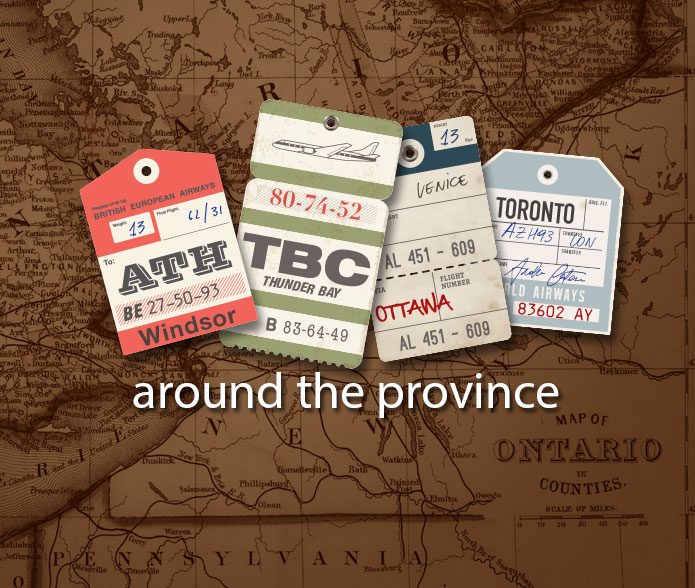Can mentorship help you in a career transition? Toby explores this as he recounts his decision to walk away from a tenure-track faculty position to become a librarian. Through OLA MentorMatch, he met with Jennifer Peters who helped him find where to focus on his job search.
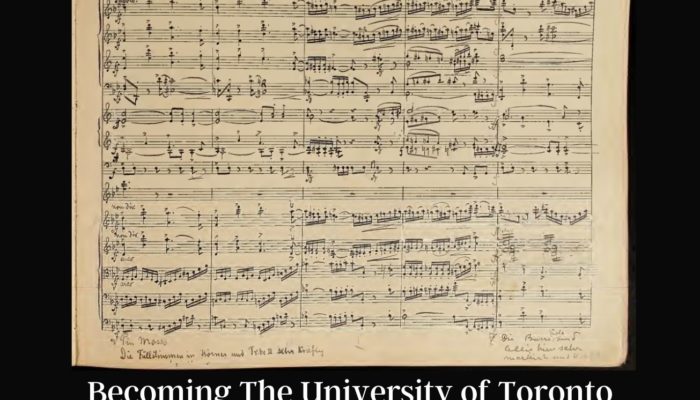
A history
In 1921, the Faculty of Music at the University of Toronto (which was established in 1918) took over the operation of what was then the Toronto Conservatory of Music’s library. This year marks our 100th anniversary, and we are grateful to the editors of Open Shelf for the opportunity to document our history, current state and special collections in a series of articles over the coming months. This month, we trace the Library’s history.
*Since this piece’s publication, the 6th paragraph has been revised and updated for accuracy.*
In 1921, University of Toronto Faculty of Music took over operation of the Toronto Conservatory of Music’s library. The library remained in the Conservatory building through the first half of the 20th century. Its collection was added to through gifts-in-kind from the local musical community and purchases by the University of Toronto Central Library.
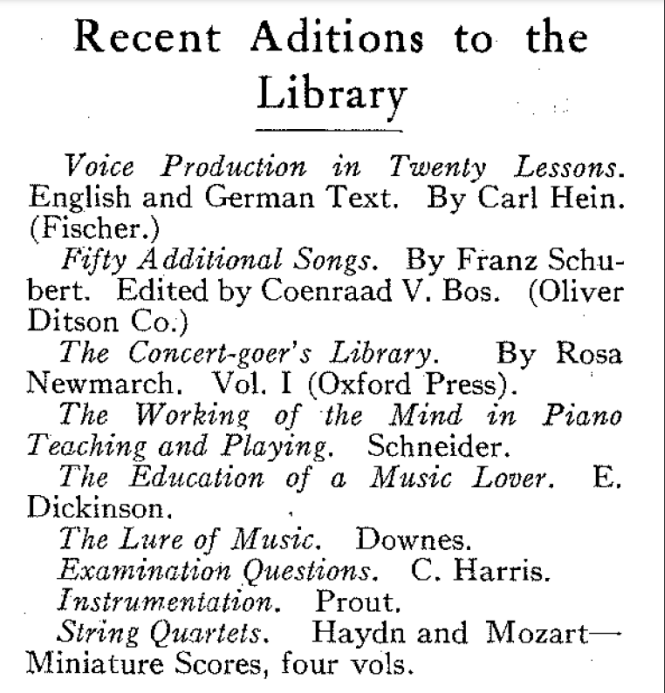
Kathleen McMorrow makes a compelling case for Hugh Hornby Langton (UofT’s Chief Librarian, 1892-1922) having spearheaded “the university’s official commitment to a music collection” (“The Origins of the Music Collections,” p.16). Langton was an accomplished amateur musician who donated approximately two dozen musical scores from his personal collection in 1922. In addition, “Langton had just returned from a European buying trip for the library, and its results included the addition of a dozen books on music, plus recent scores such as Stravinsky’s Chant du rossignol and Sacre du printemps, and of several early tone poems by Richard Strauss, purchased presumably from his general discretionary fund” (p.16). He continued donating items from his own substantial personal music collection until his death in 1950.
In 1927, a description of the newly re-organized music library appeared in the Conservatory Quarterly Review:
“It has been fully catalogued, re-arranged, and also augmented by several valuable musical works, so that we now have for the use of teachers and students a fully equipped circulating library of musical works … all books may be readily seen and consulted, while those who desire to borrow a copy may do so by application to the librarian” (“The Conservatory Library,” 1927, p.143).
The librarian used a basic classification system, with books grouped in seven categories (biography, fiction, history, organ, voice, piano and theory) and scores in eight categories (oratorio, opera, songs, anthems, piano, organ, chamber music and orchestral works).
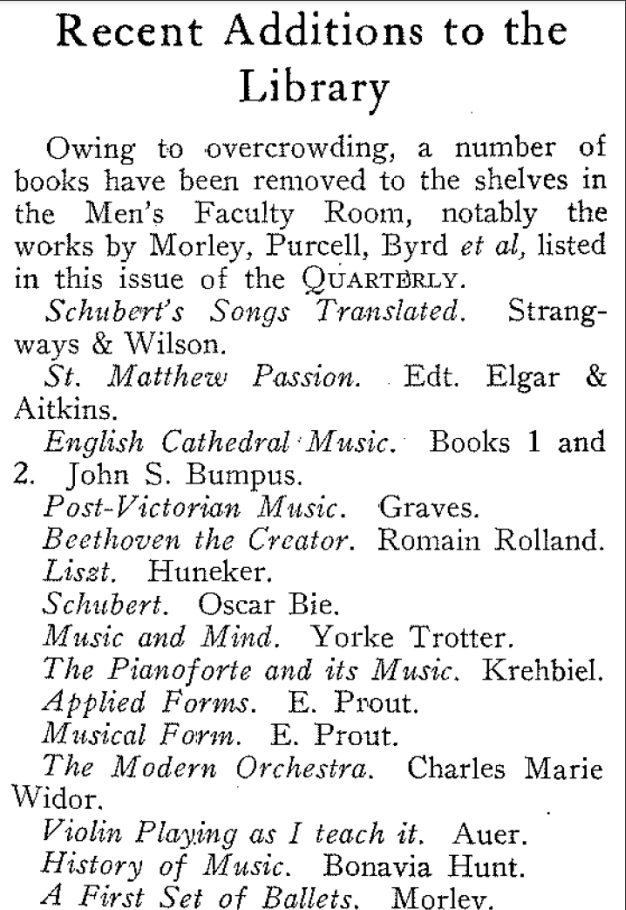
It did not take long for the library to run out of space; the Conservatory Quarterly Review from 1930-31 mentions overcrowding. The expanding music collection was moved to a new location in 1934, and re-organized by members of the Association of Women Teachers. Dean of Music Dr. Ernest MacMillan asked colleague Dr. Healey Willan to supervise this work. A notice appeared in the Conservatory Quarterly Review celebrating the library’s new, improved location: “Adelaide Dingman Bartmann was assigned the task of installing a system whereby the Library might be used to better advantage by teachers and students alike. For three months Mrs. Bartmann has been deeply engrossed in the work of classifying, cataloguing, card indexing, and numbering the hundreds of volumes…” Following the move:
“Miss Lillian Bath of the Conservatory Office Staff [was] appointed Librarian.” Notable special collections at this time were “a very rare and unique collection of books printed during the seventeenth and eighteenth centuries, which includes theory textbooks, songs, glees, ballads, music of the “Indian Queen”, “Tempest”, etc., is on display in a separate glass cabinet” (“The Conservatory Library,” 1935, p.25).
Miss Jean Lavender became Head Librarian in 1947. Through the first half of the 20th century, the Chief Librarian and the Central Library continued funding music purchases, and by the 1950s, the collection occupied two spaces: the Central Library housed scholarly works (critical editions of scores, reference materials, periodicals), and the Conservatory Library housed performing editions of scores as well as instructional materials. The collections also benefited from gifts-in-kind through the years. Both the expanding Faculty of Music and its library collections needed more space, and in 1962 the University opened the Edward Johnson Building (EJB). Edward Johnson was a Canadian opera singer who served as General Manager of the Metropolitan Opera (New York City) from 1935-1950 (MacMillan et al). Miss Lavender oversaw the bringing together of the two disparate collections into one Edward Johnson Library. At this time, the collection was comprised of 80,000 volumes (books, journals, music scores) and several thousand 78 rpm and 33 ⅓ rpm records.
In 1974 Kathleen McMorrow was appointed as The Librarian (i.e., the head librarian) with Jean Lavender the Reference Librarian until her retirement in 1983. By the 1980s Music Library contained over 130,000 books, journals, music scores, and microforms. There were 80,000 LPs and 85,000 78rpm discs in the Sniderman Recordings Archive, so named for the generous donations and standing orders arranged with Sam Sniderman (of the eponymous and iconic record-shop “Sam the Record Man”). A series of grants from the Social Sciences and Humanities Research Council of Canada (SSHRC) funded the acquisition of late-19th and early-20th Century music scores to fill important gaps. Notable special collections at this time were late 18th- and 19th-century French opera materials, 6,000+ opera librettos housed in the University’s Fisher Rare Books Library, 19th- and early 20th-century Canadian Sheet music, early treatises and histories, madrigal part books, and early Mozart and Handel editions. The Library was also building archival collections such as that of Edward Johnson (quick bio), which includes his scores, recordings, signed photographs, medals and other awards.
The Faculty of Music expanded yet again in the late ‘80s; the Rupert Edwards wing of the EJB opened in 1990. Much of the wing was devoted to a new Music Library. Comprising two levels, the Library now had double the floor space (approx 18,000 sq ft), as well as a climate-controlled vault for rare and special materials. With the opening of the new space, the Library also assumed responsibility for the ensemble collections, sets of conductor scores and parts for large ensembles such as the University choirs, orchestra and jazz orchestra.
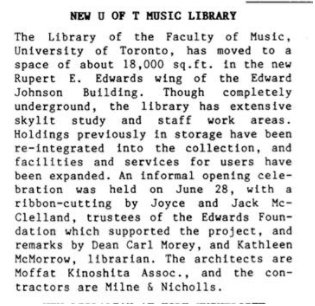
In subsequent issues of Open Shelf throughout 2021, we will discuss each of our special collections in more depth (ensemble collections, archives, and rare books) and outline some of the unique challenges that face music libraries (e.g. cataloguing, collection development, and binding/preservation). The next issue will feature some of the anti-racism and diversity, equity, and inclusion initiatives we have undertaken in the past year. In the meantime, be sure to follow us on Instagram @uoftmusiclib as our expert staff take turns highlighting an item for each of our 100 years from our collections. You can also read our blog Notes from the Music Library which is published bi-weekly.
References
“The Conservatory Library.” Conservatory Quarterly Review. vol. 9 (1927): 143.
“The Conservatory Library.” Conservatory Quarterly Review. vol. 17 (1935): 24-25.
“Recent Aditions to the Library.” [sic] Conservatory Quarterly Review. vol. 11 (1928-29): 33.
“Recent Additions to the Library.” Conservatory Quarterly Review. vol. 13 (1930-31): 37.
Kallmann, Helmut, and Richard Green, “Music Libraries“. In The Canadian Encyclopedia. Historica Canada. Article published October 20, 2011; Last edited December 16, 2013.
McMillan, Barclay, and Elaine Keillor, and James B. McPherson, “Edward Johnson“. In The Canadian Encyclopedia. Historica Canada. Article published January 29, 2008; Last Edited April 20, 2015.
McMorrow, Kathleen. “The Edward Johnson Music Library.” Fontes Artis Musicae, vol. 34 no. 4 (1987): 239-240.
McMorrow, Kathleen. “The Origins of the Music Collections in the University of Toronto Library: A Tale of Two Scores.” Notes, vol. 59 no. 1 (2002): 9-19.
Janneka (Jan) Guise is the Director of the Music Library at the University of Toronto. Prior to joining the U of T in 2017 she was Head of the Eckhardt-Gramatté Music Library at the University of Manitoba for 10 years. She has also worked in academic libraries in Newfoundland and Labrador, Alberta, and Kansas. Jan has served on the Board of the Canadian Association of Music Libraries, Archives, and Documentation Centres (CAML) in several capacities and was President from 2011-2013. She currently serves as Treasurer on the OLA Board and is a co-Lead Editor for the open access journal CAML Review.
